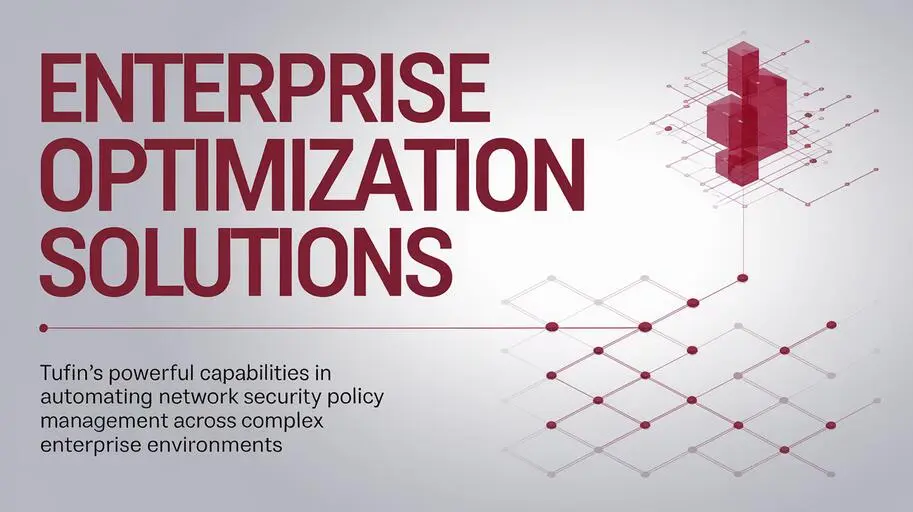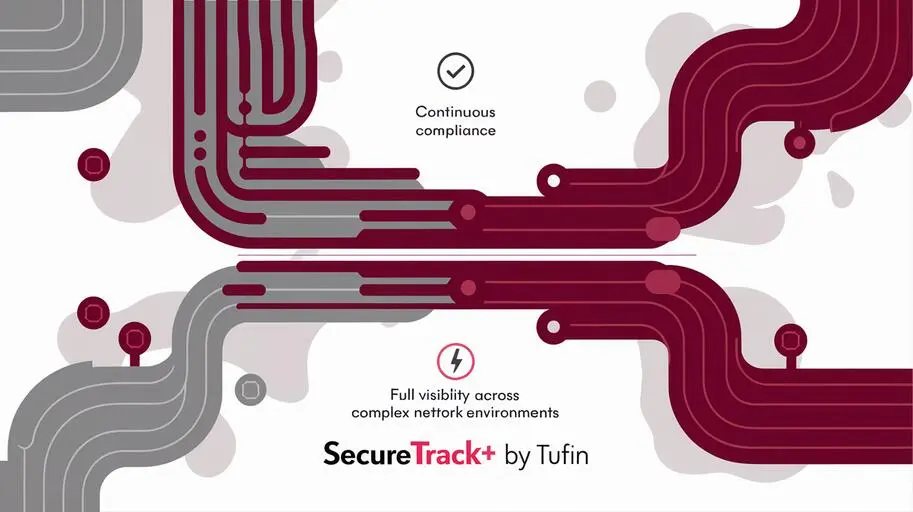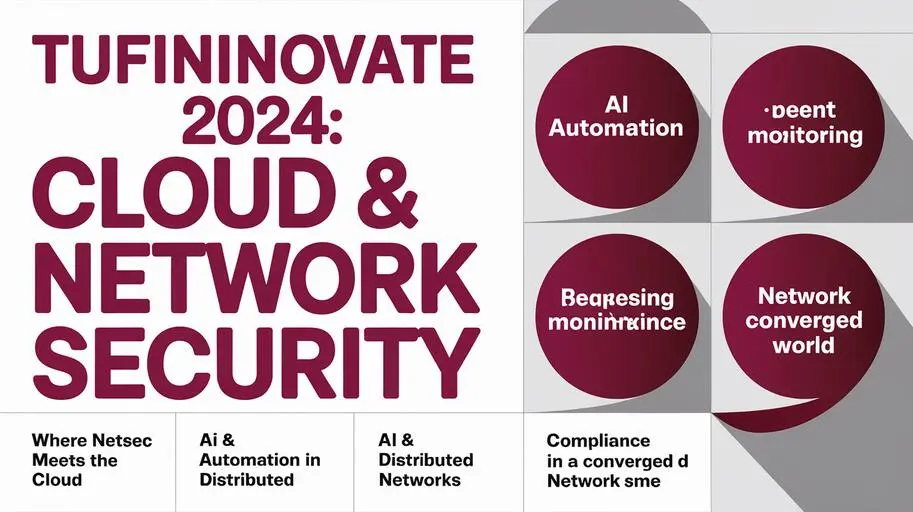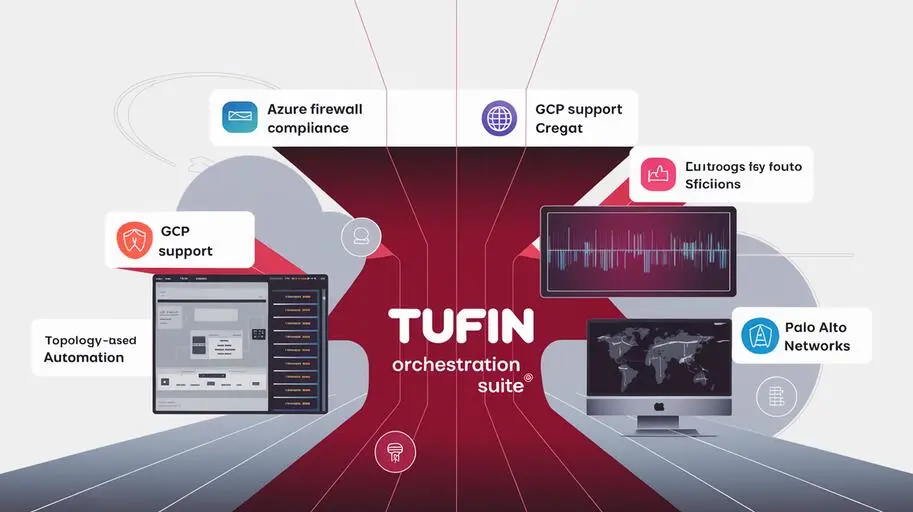
In today’s digital world, where cyber threats are becoming increasingly sophisticated and frequent, effective management of network security policies is critical to protecting corporate infrastructure. Manual management of these policies is a laborious, error-prone, and non-scalable process. Tufin offers a comprehensive solution for automating security policy management across the hybrid network, including firewalls, cloud platforms, and microsegmentation, enabling organizations to significantly simplify and optimize security management, reduce risks, and ensure regulatory compliance.
Why is Network Security Policy Management a Complex Task?
Managing security policies in large organizations is a complex and multifaceted task that includes:
- Maintaining the relevance and consistency of multiple rules across different firewalls, cloud platforms, and microsegmentation systems.
- Ensuring compliance with regulatory requirements such as PCI DSS, HIPAA, and GDPR in a distributed infrastructure.
- Responding promptly to changes in network infrastructure and business requirements, minimizing downtime and ensuring flexibility.
- Minimizing risks associated with misconfiguration, outdated rules, or conflicting policies that can lead to security breaches.
- Lack of qualified specialists with experience working with various security platforms and tools.
All these factors lead to increased operating costs, increased risk of errors, and a reduced overall level of network security. Automating security policy change management processes with Tufin addresses this problem by providing centralized management, auditing, and compliance.
Tufin: Comprehensive Solution for Network Security Policy Management
Tufin is a platform for managing hybrid network security policies, providing centralized policy management, rule optimization, configuration monitoring, and compliance auditing. The Tufin platform consists of several key components:
- SecureTrack: provides monitoring of the state of firewalls, cloud platforms, and microsegmentation systems, traffic analysis, and also provides tools for optimizing security policies, identifying redundant rules, and assessing risks.
- SecureChange: automates the process of making changes to security policies, ensuring compliance with security policies and regulatory requirements. Automates the workflow of changes passing through the hybrid network.
- SecureApp: allows you to define and visualize applications and their relationships, as well as automate the application of security policies based on business requirements of applications, supporting microsegmentation.
- SecureCloud: provides security management and visibility in cloud environments, including AWS, Azure, and GCP, allowing organizations to apply consistent security policies in the hybrid cloud.
Tufin Architecture
The Tufin architecture is designed for scalability, reliability, and security. It includes the following main components:
- Central Tufin server: manages all aspects of the platform, including data collection, analysis, reporting, and automation. The Tufin database typically uses PostgreSQL.
- Data Collectors: collect information from various firewalls, cloud platforms, microsegmentation systems, and other network devices. Collectors can be deployed in both physical and virtual environments.
- Database: stores data on security policies, rules, traffic, security events, and audit results.
- Web interface: provides users with access to the platform for management, monitoring, reporting and automation.
Tufin API
The Tufin API allows you to integrate the platform with other IT infrastructure management systems, such as SIEM, vulnerability scanners, ITSM and Service Desk. This provides a more complete picture of network security and simplifies incident management processes. Examples of specific integrations:
- Integration with ServiceNow allows you to automate the workflow of changes in security policies based on service requests.
- Integration with Splunk allows you to correlate security events collected by Tufin with other data to identify complex threats.
- Integration with vulnerability scanners, such as Qualys and Rapid7, allows you to take into account the results of vulnerability scanning when creating security policies.
Optimizing Security Policies Using Tufin SecureTrack
Tufin SecureTrack provides advanced capabilities for monitoring and optimizing security policies. It allows you to:
- Visualize existing security policies and their relationships in the hybrid network.
- Identify redundant, outdated, and potentially dangerous rules.
- Automatically generate recommendations for optimizing rules, including removing unused rules, merging similar rules, and changing the order of rules.
- Conduct risk analysis to identify potential threats associated with specific rules.
SecureTrack provides various reports, for example:
- Report on unused rules, allowing you to identify rules that are no longer needed and can be removed.
- Report on rules with excessive permissions, indicating rules that grant users or applications more access than necessary.
- Report on changes to security policies, showing what changes were made, by whom, and when.
Thanks to these features, SecureTrack helps organizations significantly improve the efficiency of security systems, reduce risks, and simplify access policy management.
Examples of Security Policy Configuration in Tufin
SecureTrack allows you to configure security policies that meet specific business requirements and regulatory requirements. Examples:
- Deny access to databases from non-corporate networks to prevent unauthorized access to sensitive data.
- Allow access to the web server only from specific IP addresses to limit the attack surface and protect the web application from external threats.
- Limit interaction between applications based on their roles and business requirements, implementing microsegmentation to reduce the risks of threat propagation.
These policies can be applied to individual security devices, groups of devices, or the entire network.
Automating Changes to Security Policies with Tufin SecureChange
Tufin SecureChange automates the processes of making changes to security policies, ensuring compliance with security policies and regulatory requirements. It allows you to:
- Automatically check change requests for compliance with security policies and regulatory requirements.
- Generate tasks for the relevant specialists responsible for making changes.
- Automatically make changes to security devices after the request is approved.
- Keep a detailed log of all changes made to security policies.
Automating security policy change management processes with Tufin significantly reduces the time required to make changes, reduces the risk of errors, and ensures regulatory compliance.

Tufin SecureChange workflow Reviewer
Tufin SecureChange workflow Reviewer simplifies the process of approving change requests. It provides an intuitive interface that allows reviewers to quickly assess requests and make decisions based on clear criteria and policies.
Tufin Integration with ServiceNow
Tufin integration with ServiceNow allows you to automate change management processes related to service requests. When a user submits a service request in ServiceNow, Tufin automatically checks the request for compliance with security policies and creates a task to make changes to security devices.
Application Management with Tufin SecureApp
Tufin SecureApp allows organizations to define and visualize applications and their relationships, as well as automate the application of security policies for these applications. It allows you to:
- Automatically discover applications running on the network.
- Visualize the relationships between applications and network resources.
- Define security policies for each application based on its business requirements and risk level.
- Automatically apply security policies to security devices and cloud platforms.
SecureApp can be used for microsegmentation of applications, limiting the interaction between applications and network resources based on the principle of least privilege. This helps reduce the risks of threat propagation and protect critical applications.
Centralized Network Security Policy Management with Tufin
Centralized management is one of Tufin’s key advantages. The platform allows organizations to:
- Manage network security policies from a single console for the entire hybrid infrastructure.
- Ensure consistency of security policies on all security devices and cloud platforms.
- Quickly and effectively respond to changes in network infrastructure and business requirements by making changes to security policies centrally.
- Simplify auditing and compliance by providing a single source of information about security policies and their compliance with regulatory requirements.
Centralized network security policy management with Tufin significantly simplifies network management, reduces risks, and improves the level of security.
Security Reporting and Event Notifications
Tufin provides extensive security reporting and event notification capabilities. The platform allows you to:
- Create reports on the status of security devices, rules, and traffic.
- Receive notifications of important security events, such as changes to rules, detection of suspicious traffic, and violation of security policies.
- Integrate security reports with other IT infrastructure management systems.
Examples of the types of reports that Tufin can generate:
- Compliance report showing compliance of security policies with PCI DSS, HIPAA, GDPR and other standards requirements.
- Policy change report that allows you to track who, when, and what changes were made to the configuration of security devices.
- Report on detected vulnerabilities in the configuration of security devices, helping to identify and eliminate potential security breaches.
Monitoring the status of security devices and traffic in Tufin helps organizations quickly respond to security incidents and maintain a high level of network protection.
Managing Security Policies for Compliance with PCI DSS, HIPAA, GDPR, and Other Regulatory Requirements
Tufin helps organizations comply with various regulatory requirements, such as PCI DSS, HIPAA, and GDPR. The platform provides tools for:
- Automatic scanning of security devices for compliance with regulatory requirements.
- Generating reports on compliance with regulatory requirements.
- Automatically making changes to security devices to ensure compliance with regulatory requirements.
Specific examples of how Tufin helps meet the requirements of various standards:
- PCI DSS: Tufin helps meet PCI DSS requirements for network segmentation, access control to card data, auditing changes to rules, and traffic monitoring.
- HIPAA: Tufin helps meet HIPAA requirements for protecting confidential medical information, controlling access to data, auditing user activity, and encrypting data during transmission and storage.
- GDPR: Tufin helps meet GDPR requirements for protecting personal data, ensuring transparency of data processing, controlling access to data, and responding to requests from data subjects.
Auditing compliance with Tufin simplifies the compliance process and reduces the risk of penalties for violating regulatory requirements.
Tufin Integration with SIEM and Vulnerability Scanners
Tufin integrates with various SIEM and vulnerability scanners, such as:
- Splunk
- IBM QRadar
- Qualys
- Rapid7
Tufin integration with SIEM and vulnerability scanners provides a more complete picture of network security and simplifies incident management processes.
Benefits of Using Tufin to Automate Security Policy Management
Using Tufin to automate security policy management provides organizations with the following benefits:
- Reducing operating costs by automating manual tasks, reducing downtime, and optimizing resource utilization.
- Improving the level of network security through centralized management, automatic detection and elimination of vulnerabilities, as well as compliance with regulatory requirements.
- Simplifying network management with a single management console, automated workflows, and integration with other systems.
- Ensuring compliance with regulatory requirements through automatic configuration monitoring, report generation, and making the necessary changes.
- Reducing the time required to make changes by automating workflows, parallel changes, and testing changes before applying them.
- Reducing the risk of errors by automatically checking changes for compliance with security policies and regulatory requirements, as well as using templates and best practices.
These benefits make Tufin an indispensable tool for any organization striving for effective and secure management of its network.
Tufin is a powerful and comprehensive solution for managing network security policies that enables organizations to significantly simplify and optimize security management, reduce risks, and ensure regulatory compliance. With its advanced monitoring, automation, reporting, and integration capabilities, Tufin is an indispensable tool for any organization striving for effective and secure management of its network.
Want to learn more about how Tufin can help your organization improve network security and simplify security policy management? Contact us for a personalized consultation and solution demonstration.
FAQs on: Firewall Management with Tufin
-
Why is firewall management considered a complex task?
Managing firewalls in large organizations is complicated by the need to maintain the relevance of numerous rules, ensure compliance with regulatory requirements (PCI DSS, HIPAA, GDPR), respond promptly to changes in the network, and minimize risks associated with incorrect settings. A shortage of qualified specialists is also a problem. -
What is Tufin and what components are included in its platform?
Tufin is a network security policy management platform that provides centralized firewall management, rule optimization, monitoring, and auditing. The platform consists of SecureTrack (monitoring and optimization), SecureChange (change automation), and SecureApp (application management). -
How does Tufin SecureTrack help in optimizing firewall rules?
Tufin SecureTrack provides capabilities for visualizing rules, identifying redundant and outdated rules, automatically generating optimization recommendations, and conducting risk analysis related to specific rules. -
What does Tufin SecureChange automate?
Tufin SecureChange automates firewall change processes, ensuring compliance with security policies and regulatory requirements. It automatically checks change requests, generates tasks for specialists, and makes changes to firewalls after the request is approved. -
What role does Tufin SecureApp play in application management?
Tufin SecureApp allows organizations to define and visualize applications, as well as automate the application of security policies to them. It automatically discovers applications, visualizes the relationships between them and network resources, and applies security policies to firewalls. -
Why is centralized security policy management important in Tufin?
Centralized management allows you to manage network security policies from a single console, ensuring policy consistency across all devices, and quickly and efficiently respond to changes in the network infrastructure. -
What security reporting capabilities does Tufin provide?
Tufin provides the ability to create reports on the status of firewalls, rules, and traffic, as well as receive notifications about important security events, such as changes to rules or the detection of suspicious traffic. -
How does Tufin help comply with regulatory requirements such as PCI DSS, HIPAA, and GDPR?
Tufin provides tools for automatically scanning firewalls for compliance with regulatory requirements, generating compliance reports, and automatically making changes to ensure compliance. -
What types of systems does Tufin integrate with?
Tufin integrates with SIEM (Splunk, IBM QRadar) and vulnerability scanners (Qualys, Rapid7) systems, as well as ITSM (ServiceNow) to provide a more complete picture of network security. -
What are the main advantages of using Tufin for automated firewall management?
Key benefits include reduced operating costs, improved network security, simplified management, regulatory compliance, reduced time required for changes, and reduced risk of errors.




